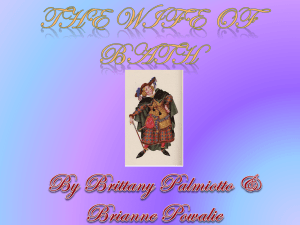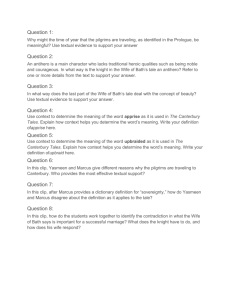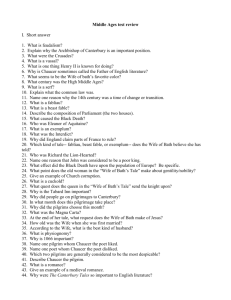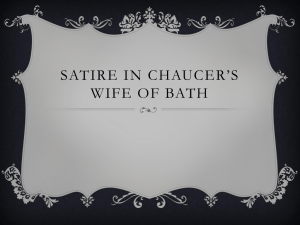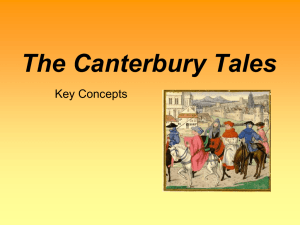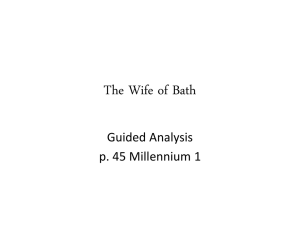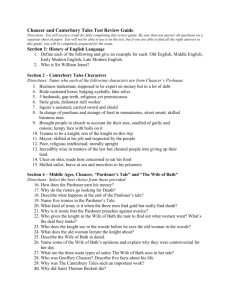Critical Review of the Wife of Bath`s Psychoanalytical Critique
advertisement
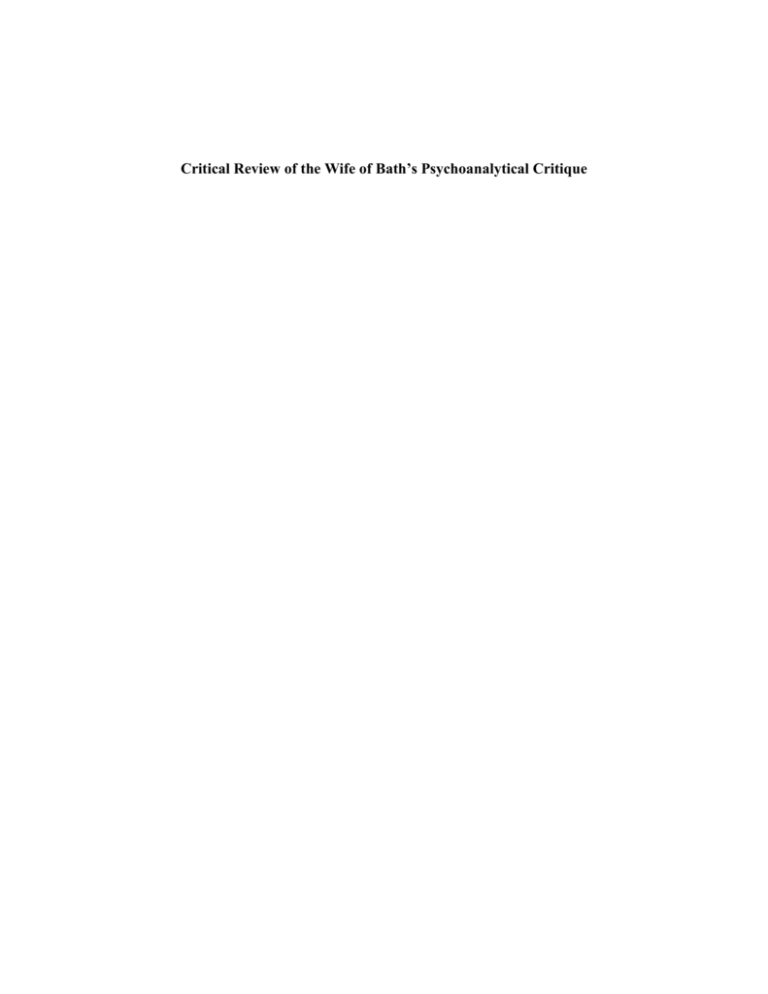
Critical Review of the Wife of Bath’s Psychoanalytical Critique Louise O. Fradenburg’s case study of The Wife of Bath’s tale is based on Sigmund Freud’s psychological perspective on fantasy and wish-fulfillment. Although there are many fine points in the critical review that I acknowledge to be true, I would have to say I disagree with the overall premise of her article due to the inherent weakness of psychoanalyzing literary characters. Although it’s possible to copy over the disorders and patterns of thinking from person to paper, characterization is always going to be impaired by the needs of plot and rhyme. There are also many details that were not thoroughly explained to my general satisfaction. Fradenburg first discusses how modern the Chaucer’s Wife of Bath seems and how the old witch in the tale symbolizes Alison and her fear of growing old and dying. Taking after Sigmund Freud, Fradenburg explains how romance and fantasy is used as a means of escaping from the problems of the real world, a source of why many people fear it. She cites other critics who view Alison as interpreting the scripture to fit her own philosophy of sex, money and domination. Fradenburg then relates how she wishes to divert our attention away from these notions and consider the positive way Chaucer shows that fantasy can affect reality. In the section titled “True Romance”, Fradenburg cites Freud for using The Merchant of Venice and King Lear as examples of myths in which the protagonist faces a choice of three, of which the best choice, which is the least valuable of the three, symbolizes death. Freud argues that everyone unconsciously believes they will never die. These examples, however, exemplify the hero choosing death rather than hiding from reality, thus making death seem desirable. Fradenburg then turns back to Chaucer and relates how the knight’s ignorance of women’s desires is fantastically imparted to him by a witch from the land of the fairies, which “turns multifarious and confusing data about women’s preferences into a single truth about a species.” (Fradenburg p.209) She reminds us how this truth about woman’s wish for sovereignty frees him from his own death sentence and how submission to this sovereignty magically turns into its opposite: freedom of choice. Fradenburg explains the difference between the crone’s curse against coveting money and the Wife of Bath’s own ventures into sexual bartering as the distinction between the real world and her fantasy world. Fradenburg then compares the complaints of romance critics to Bassanio in the Merchant of Venice for finding fault in not portraying realism, both preferring the real world to the “glittery” character reminiscent of the fantasy and romance genre. Fradenburg identifies such critics as repeating the wish inherent in romance: “that necessity can be turned into choice, death into a better life”. She closes by saying that while the backdrop to romance is fantasy, these traditions can also help us “renounce fairy land” and live better lives secured in this reality. In the second section, “Mortality and the Subject”, Fradenburg moves away from the tale and explains how through psychoanalytic therapy a subject reveals inner desires by talking about the past. In theory, everyone begins life without an identity, or ego, that separates itself from its own pleasures and pains. As the subject grows, he or she moves away from being “polymorphous perverse”, having a varied array of infantile pleasures, to a more structured form of pleasure-seeking. But because our identities are shaped in the past that molded our egos, we are always unconsciously seeking fond memories in our own history to make up for feelings of loss. Similarly, the Wife of Bath is seeking fulfillment from the sexual experimentations of her youth. Fradenburg then uses an explanation of the Oedipal complex to segue into how parental desires can be passed on to the next generation and how this affects an unconscious social structuring called the symbolic order. In “Fantasy Makes the World” Fradenburg explains how fantasies that are created to replace the disenchantment of the real world are easily regulated to a mythical time in history. To Alison, Camelot is a world where her desires and fears expressed in her prologue come to life. The fairy tale ending, like other Cinderella endings, represent alliances between commoners and aristocrats. The disappearance of the twenty-four ladies symbolizes the disappearance of Alison’s happiness. Fradenburg then comes to the subtle conclusion of The Wife of Bath: the ruling class will achieve regeneration of the body and perpetual youth by marrying into the common wealth. I of course agree that the old crone in the tale represents Alison and I can appreciate the premise of the “triple choice” theme: that the best choice can be the most humble, but the connection made between the best choice and death puzzles me. In King Lear, it was not the act of choosing Cordelia that brought Lear down the path to destruction. Freud may have given this identification more concrete footing, but Fradenburg did not give me enough circumstantial evidence to accept it. I do concur with the notion that fantasy and romance can be used to more poignantly portray the problems in the real world. Although at first the comparison made about romance critics and the “triple choice” seemed to be a reach, the more I considered the common reoccurrence of the Cinderella theme in fantasy and romance, the more I opened up to that assessment. Psychoanalyzing literary characters has its dangers. All literary characters are, to a point, idealizations, limiting the effectiveness of analyzing techniques. As mentioned in the preface, many of Freud’s disciples have such reservations about these concerns, although Freud himself did not. Another limitation is the availability of information on the subject; the Wife of Bath is a rather short story. Complications arise when considering plot expansion. For instance, how can one tell if the Wife of Bath is relating her past five marriages in fulfillment of secret desires to relive her past, or because there is no other way for Chaucer to impart her history to his audience? On the optimistic side, just as parents can unconsciously impart character traits on their children, so authors can do the same to their own “children”. For a psychoanalytical approach based on the Wife of Bath’s feminine personality and not one that probes the mind of Chaucer, we must assume the Wife of Bath is based on one or more real women. This is possible because Chaucer could have related the connection between being married at an extremely young age and having male resentment issues without having to understand it in the Freudian sense. But if Alison did not have any real-life counterparts, then we cannot speak with any real confidence of her being “polymorphous perverse”, unless the critic should credit the connection to the psychology of the author. That being said, I found Fradenburg’s elaboration on oral fixations insightful, even when the connection to the Wife of Bath was tenuous at best. I agree that Alison’s desire for continuous remarriages does express some kind of dysfunction, although as to whether it derives from adolescent sexual experimentation, I’m not so sure. I agree that the theme of marriages between nobility and the commonwealth in fairy tales represents the desire for alliances between the two social classes, and I have more confidence in the disappearance of women being a symbol for disappearing feelings than before. I thought that Camelot was already the perfect world in which the Wife of Bath was presenting, and if the witches disappear in that time period, then that would mean her paradise would already be degrading. But, the story could still feature an underlying theme that connects back to Alison’s world. I agree with the conclusion that the tale promises perpetual youth and beauty if nobility is prepared to marry the commonwealth, but I see this as only one side of it. It also represents the young being willing to marry the old and most of all, men being prepared to acquiesce to the will of womankind. I do not see this as reason for nominating the story as a voice towards social change. Rather, such pleasantries in the ending are overshadowed by the Wife of Bath’s selfish desire to control men instead of wishing to share the decision-making process. I see Chaucer as satire above anything else. Albert Einstein noted in his own time how even critics of Freud tend to use the language he imparted to the psychological world, yet at the same time, his most ardent supporters were known to split with him and form their own schools of thought. Psychotherapy can be a divisive subject, one in which it is easy to disagree with similarly educated practitioners. It is because of this that I feel psychotherapy and its literary discourses are best relegated to real life subjects who are able to supply responses to the ever-important questioning process that facilitates psychoanalytic theory. Unfortuanately, only the author can tell us exactly how much of a separation there is between the character and the author.
